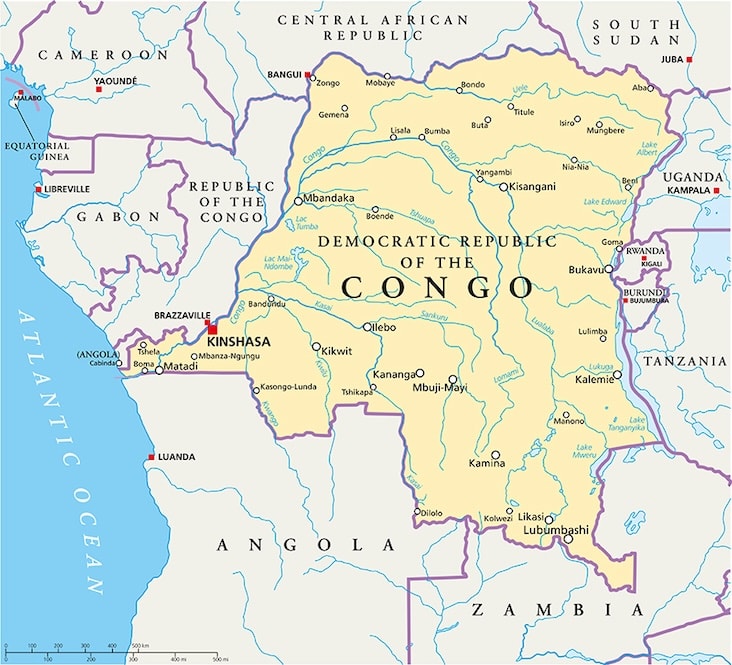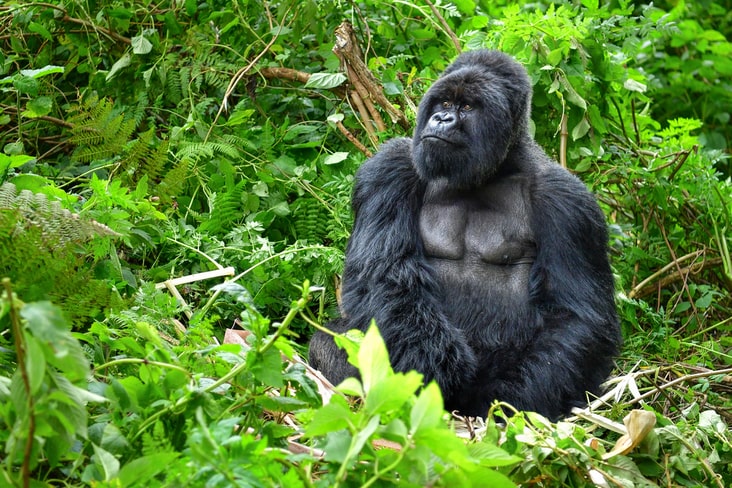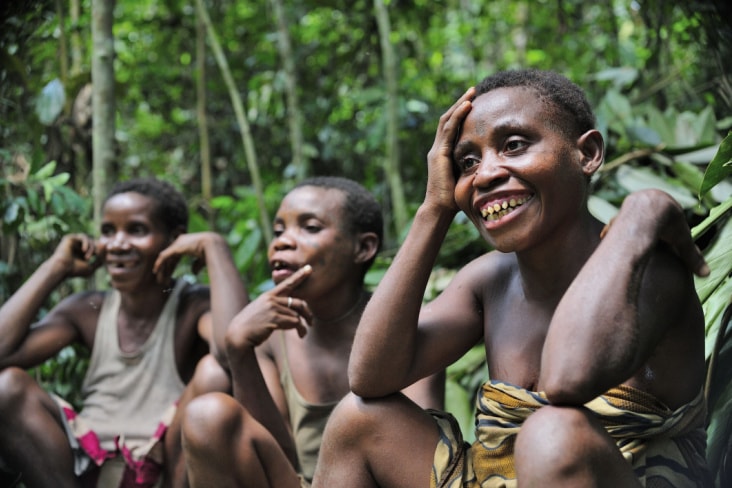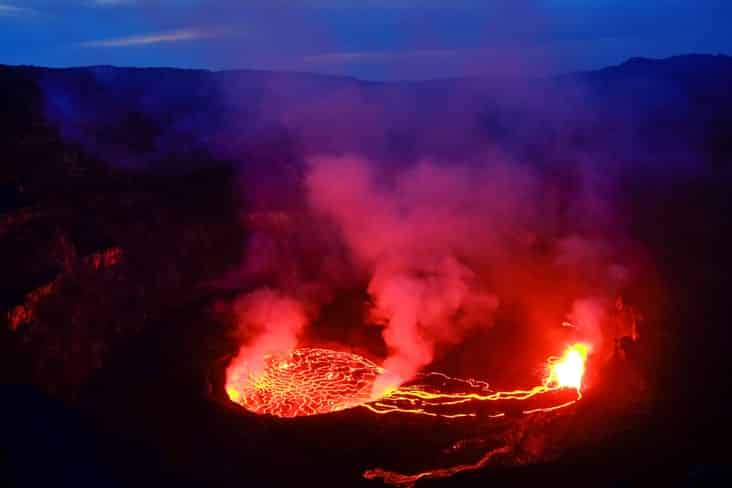From diverse flora and fauna to a tragic history, these are the most interesting facts about the Democratic Republic of Congo.

Fast facts
Official name: Democratic Republic of the Congo
Capital city: Kinshasa
Population: 111.8 million
Area: 2,344,858 sq km
Major languages: French, Lingala, Kingwana, Kikongo, Tshiluba
Time zone: UTC+1 (West / Central African Time)
Interesting facts about the Democratic Republic of Congo
1. The Democratic Republic of Congo in Central Africa is often referred to as DRC, DR Congo and sometimes Congo (Kinshasa) to distinguish it from the Republic of the Congo which is often referred to as Congo (Brazzaville).
Note: we refer to the Democratic Republic of Congo (DRC) as DR Congo below.
2. Harpoon tips discovered on the banks of the Semliki River in DR Congo are more than 90,000 years old and some of the earliest instruments ever shaped by modern humans using a material other than stone or wood.
3. The Kingdom of Kongo ruled much of the region from the 14th to 19th centuries.

4. In 1482, Portuguese navigator Diogo Cao became the first European to visit the Congo setting up ties with the king of Kongo.
5. Belgium’s King Léopold II set up a private venture to colonize Kongo from the 1870s onwards. The colony was the largest private estate ever acquired by a single man and possibly led to the deaths of 10 million people.
6. DR Congo’s flag consists of a blue background with a yellow-bordered red diagonal stripe running across it and a yellow star in the top left corner. The flag dates from 1877 and was initially blue with a gold star symbolizing a shining light in the “Dark Continent.”

7. In 1960, DR Congo finally gained independence from Belgium.
8. DR Congo’s recent history has been plagued by civil war, conflict and political upheaval. It has been at the centre of what has been called “Africa’s world war”, which directly or indirectly killed up to six million people.
9. In 1971, the country was renamed Zaire and the River Congo became the River Zaire following a military takeover. The country reverted to the Democratic Republic of Congo in 1997.
10. At 2,900mi (4,700 km), the Congo River, which runs through DR Congo, is Africa’s second-longest river after the Nile. It is also the world’s deepest river.

11. From 1874-77, famed British explorer Henry Stanley became the first to navigate the Congo River to the Atlantic Ocean. The city of Kisangani (Stanleyville) and the Boyoma Falls (Stanley Falls) were named after him. The Boyoma Falls are a 100km (60mi) stretch of seven cataracts that are the last point ships can travel upriver from Kinshasa.
12. DR Congo’s capital city, Kinshasa, is located on the Congo River opposite Brazzaville, the capital of Congo (Republic of Congo). The two cities are 2.96 mi (4.76 km) apart, making them the closest capital cities in the world. Rome and Vatican City are closer, but Vatican City is not a UN member and as it’s a city-state, it technically doesn’t have a capital.
13. From 1881, Kinshasa was called Léopoldville after King Léopold II of Belgium. In 1966, the city was renamed Kinshasa, after a village that once stood near the site.
14. DR Congo’s capital city Kinshasa, with a population of more than 12 million, is the world’s largest French-speaking city.

15. The world’s second-largest rainforest, the Congolese Rainforest, is part-located in DR Congo. The Congolese Rainforest spans six countries: Cameroon, the Central African Republic, the Republic of the Congo, Equatorial Guinea and Gabon.
16. The Congo Basin spans six countries including DR Congo. The Congo Basin makes up one of the most important wilderness areas on Earth and is home to approximately 10,000 plant species, 400 mammal species, 1,000 bird species and 700 fish species.
17. As such, DR Congo is one of 17 megadiverse countries in the world. Megadiverse countries are the world’s most biodiversity-rich countries.

18. There are more than 200 African ethnic groups in DR Congo. The majority are Bantu with the four largest tribes – Mongo, Luba, Kongo (all Bantu) and the Mangbetu-Azande (Hamitic) – making up around 45% of the population.
19. DR Congo and the Congo Basin countries are home to the ethnic group of Pygmy people, known for their short stature – typically under five feet tall. The word “Pygmy” comes from the Greek for “dwarfish”, although pygmies are conventionally proportioned.
20. In 1904, Pygmy Ota Benga was kidnapped from what is now DR Congo and taken to the US, where he was exhibited with monkeys in a zoo. More than a century later, the Bronx Zoo in New York finally issued an apology.

21. DR Congo has five UNESCO World Heritage Sites. All are natural heritage sites and include four national parks and one wildlife reserve.
22. The UNESCO-listed Virunga National Park is Africa’s oldest national park and home to an array of wildlife and natural landscapes, including mountain gorillas and chimpanzees, as well as the active volcano Nyiragongo.
23. The DR Congo is home to the endangered okapi, a unique creature often referred to as the “forest giraffe” due to its appearance resembling a blend of a deer and a zebra. The okapi is found exclusively in the wild within the Ituri Rainforest of the DR Congo.

24. DR Congo is the world’s 11th-largest and Africa’s second-largest country after Algeria.
25. DR Congo would be landlocked if it weren’t for a 25-mile (40-km) coastline on the Atlantic Ocean.
26. Mount Nyiragongo is one of the world’s most dangerous volcanoes and is known locally as “General Nyiragongo”. In 2002, lava from the volcano destroyed part of the nearby city of Goma.

27. DR Congo is potentially one of the world’s richest countries with vast natural resources including cobalt, copper, niobium, tantalum, petroleum, industrial and gem diamonds, gold, silver, zinc, manganese, tin, uranium, coal, hydropower and timber.
28. However, DR Congo is the world’s fourth poorest country when measured by GDP per capita based on purchasing power parity (PPP).
29. DR Congo records some of the lowest CO₂ emissions per capita globally, at just 0.04 metric tons per person each year, due to its low industrial output and heavy reliance on renewable biomass for energy.
Explore more from Africa
Every effort has been made to verify these facts about the Democratic Republic of Congo. However, if you find an error or have any questions, please contact us.
Caitriona Maria is an education writer and owner of The Facts Institute. A teacher for seven years, she has been committed to providing students with the best learning opportunities possible, both domestically and abroad. Dedicated to unlocking students' potential, Caitriona has taught English in several countries and continues to explore new cultures through her travels.